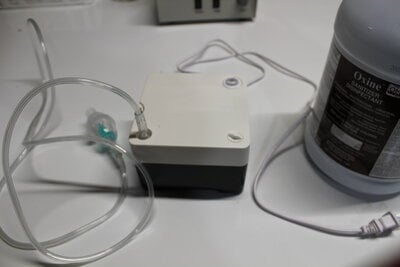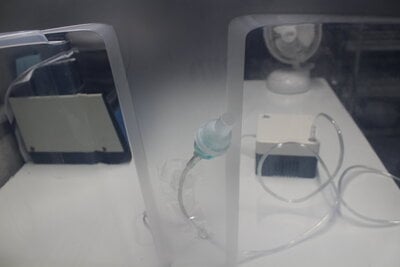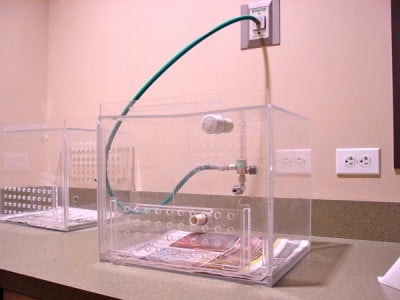Nebulization of Avian Patients
Date: March 19, 2013
By: Kimberly Mickley, DVM, DABVP (Avian Practice)
Second Author:Christal Pollock, DVM, Dipl. ABVP-Avian; Lafeber Company Veterinary Consultant
Keywords: aerosol, nebulization
Categories: Avian, Emergency Medicine
Introduction
Nebulization is used in avian medicine to deliver certain medications, usually antibiotics or antifungals, directly to the respiratory tract. Nebulization can provide hydration to the mucous membranes as well as provide an expectorant effect to help clear debris from the respiratory tract. When medicating a patient, restraint may be necessary several times day, however when nebulizing a patient restraint is needed only to place the bird in the enclosure potentially decreasing the level of stress.
Indications
Consider nebulization…
The benefit of nebulization often relates to normal airway defense mechanisms (Sierra 2012). The nares and oropharynx serve as a first line of defense for the respiratory tract in the healthy animal. Nasal passages warm and humidify inspired air, while filtering large, inhaled particles.
A second line of defense traps small particles that pass the upper airway: the mucociliary escalator. Ciliated columnar epithelium and a mucus layer secreted by goblet cells cover the trachea, primary bronchi, and the roots of the secondary bronchi. This mucus layer continuously moves up the tracheobronchial tree in an oral direction (Fedde 1998, McLelland 1989). Birds also have parabronchi and air capillaries, which are important when selecting the appropriate nebulizer.
Equipment needed
Most patients tolerate nebulization well, and complications are rare however potential problems include (Macintire 2006, Sierra 2012):
Procedure
Aerosol therapy is not limited to nebulization. Humidification and vaporization are two other forms of aerosol therapy that can be used to help manage avian respiratory diseases. These two forms do not penetrate the respiratory tract as effectively as nebulization.
On an outpatient basis, birds can receive humidified air through bathroom steam treatments or frequent showers or baths. Placing a cool air evaporative humidifier in the bird room may also be beneficial as long as the humidifier is scrupulously cleaned after every use.
https://lafeber.com/vet/nebulization-of-avian-patients/
Alleviation and treatment of respiratory distress in birds can be achieved in some cases using nebulization therapy. One can make a nebulization cage using very few supplies including a jet nebulizer, or a simple humidifier, plastic tote, and saline, or antimicrobial agent. The one below simply consists of a jet nebulizer taped against the side of the Tupperware. The medicine cup can be filled with whatever agent is desired - in this case, dilute Oxine was used. The bird can be placed inside the Tupperware where the agent can be delivered into the bird's respiratory system.
https://www.amazon.com/s?k=jet+nebu...prefix=jet+ne,aps,190&ref=nb_sb_ss_ts-a-p_1_6
https://www.revivalanimal.com/product/oxine-animal-health-ah/all-dog-and-cat-supplies


https://core.ac.uk/download/pdf/154952249.pdf
Date: March 19, 2013
By: Kimberly Mickley, DVM, DABVP (Avian Practice)
Second Author:Christal Pollock, DVM, Dipl. ABVP-Avian; Lafeber Company Veterinary Consultant
Keywords: aerosol, nebulization
Categories: Avian, Emergency Medicine
Introduction
Nebulization is used in avian medicine to deliver certain medications, usually antibiotics or antifungals, directly to the respiratory tract. Nebulization can provide hydration to the mucous membranes as well as provide an expectorant effect to help clear debris from the respiratory tract. When medicating a patient, restraint may be necessary several times day, however when nebulizing a patient restraint is needed only to place the bird in the enclosure potentially decreasing the level of stress.
Indications
Consider nebulization…
- When trying to decrease the level of stress to the patient.
- When a bird is showing signs of rhinitis, sinusitis, bronchitis, pneumonia, or air sacculitis.
- To deliver:
- Antimicrobials or antifungals, which are toxic via systemic administration. Visit Respiratory Emergencies in Birds for specific treatment recommendations.
- Agents that are only effective topically such as mucolytics.
- Potent drugs like bronchodilators for the advantage of optimal therapeutic effects with minimal systemic side effects.
- For patients receiving oxygen therapy
Continual inspiration of dry gases can irritate respiratory epithelium. Adequate airway hydration is essential in these patients since drying increases the viscosity of respiratory secretions and decreases ciliary function (see anatomy below).
The benefit of nebulization often relates to normal airway defense mechanisms (Sierra 2012). The nares and oropharynx serve as a first line of defense for the respiratory tract in the healthy animal. Nasal passages warm and humidify inspired air, while filtering large, inhaled particles.
A second line of defense traps small particles that pass the upper airway: the mucociliary escalator. Ciliated columnar epithelium and a mucus layer secreted by goblet cells cover the trachea, primary bronchi, and the roots of the secondary bronchi. This mucus layer continuously moves up the tracheobronchial tree in an oral direction (Fedde 1998, McLelland 1989). Birds also have parabronchi and air capillaries, which are important when selecting the appropriate nebulizer.
Equipment needed
- Appropriate enclosure to house the bird (Fig 1).

Figure 1. Nebulize the patient is a secure, easy to clean enclosure like this oxygen cage. Image provided by Dr. M. Scott Echols. Click to enlarge. - Sterile saline, sterile water, or medication (and diluent if necessary) to be nebulized.
- Appropriate nebulizer:
- There are two types of nebulizers: jet nebulizers (also known as pneumatic nebulizers or atomizers) and ultrasonic nebulizers.
- Ultrasonic nebulizers deliver smaller (3-10 μm) droplets in higher volumes. The denser aerosol mist created allows deeper penetration into airways (Sierra 2012).
- The size of the particle is an important point when considering nebulization therapy.
- Birds have parabronchi that range between 0.5-2 mm in diameter and air capillaries that range from 3-10 μm in diameter.
- The particle size recommended for nebulization is 3 μm.
- Ultrasonic nebulizers are preferable in birds because treatment time can be shorter and operation is quieter compared to jet nebulizers (Bowles 2007).
- Source of oxygen or air compressor
- Ventilation
Most patients tolerate nebulization well, and complications are rare however potential problems include (Macintire 2006, Sierra 2012):
- Potential toxicity to humans: Consider using a respirator to prevent staff exposure to potentially toxic agent, like amphotericin B and aminoglycosides.
- Overhydration: Brief but frequent nebulization sessions are usually sufficient to maintain airway moisture without causing fluid overload.
- Hyperthermia: The risk of overheating increases when birds are nebulized within cages sealed in plastic bags or when nebulizers with heating elements are used.
- Airway irritation: Depending on the osmolality and ingredients of the aerosolized liquid, nebulization can occasionally cause tracheobronchial irritation or bronchospasm.
- Iatrogenic respiratory infection: Bacterial and/or fungal contamination of the nebulization unit can be responsible for transmission of infection from one patient to the next.
Procedure
- Place the bird in a secure enclosure. A cage can be used but it will need to be placed in a clear plastic bag with the open end loosely closed so the particles stay within the enclosure.
- The medication to be administered is chosen depending on disease process and or culture and sensitivity results.
- Connect the nebulizer to the enclosure and deliver medication for the allotted time.
- Nebulization treatments typically last for 10-30 minutes per delivery. Short, frequent sessions of 15 minutes repeated every 4-6 hours are generally preferable.
- Monitor the patient closely for worsening of respiratory signs or signs of overheating (see complications above).
Aerosol therapy is not limited to nebulization. Humidification and vaporization are two other forms of aerosol therapy that can be used to help manage avian respiratory diseases. These two forms do not penetrate the respiratory tract as effectively as nebulization.
On an outpatient basis, birds can receive humidified air through bathroom steam treatments or frequent showers or baths. Placing a cool air evaporative humidifier in the bird room may also be beneficial as long as the humidifier is scrupulously cleaned after every use.
https://lafeber.com/vet/nebulization-of-avian-patients/
Alleviation and treatment of respiratory distress in birds can be achieved in some cases using nebulization therapy. One can make a nebulization cage using very few supplies including a jet nebulizer, or a simple humidifier, plastic tote, and saline, or antimicrobial agent. The one below simply consists of a jet nebulizer taped against the side of the Tupperware. The medicine cup can be filled with whatever agent is desired - in this case, dilute Oxine was used. The bird can be placed inside the Tupperware where the agent can be delivered into the bird's respiratory system.
https://www.amazon.com/s?k=jet+nebu...prefix=jet+ne,aps,190&ref=nb_sb_ss_ts-a-p_1_6
https://www.revivalanimal.com/product/oxine-animal-health-ah/all-dog-and-cat-supplies


https://core.ac.uk/download/pdf/154952249.pdf






